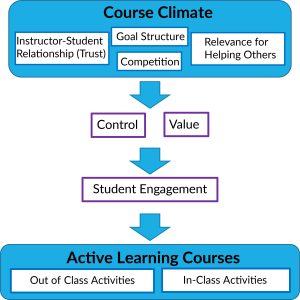Creating a Classroom Climate that Supports Student Engagement in Active Learning
On Wednesday, April 24, we hosted Dr. Sarah Eddy to discuss how course climate supports student engagement in active learning.
Active learning in STEM courses
Dr. Sarah Eddy’s research focuses on supporting marginalized learners’ motivation and success in STEM courses through instructional practices. Eddy explained that active learning strategies can positively affect student performance on exams and decrease course failure rates in STEM (Freeman et al., 2014). Additionally, active learning practices also reduce the disparities between low-income and underrepresented minority (URM) students and their normative peers (Theobald et al., 2020). However, Eddy continued, there is significant variation in the effects of active learning, and disparities continue to persist in some contexts. Dr. Eddy’s most recent work seeks to understand the factors contributing to these variations.
The term “active learning” encompasses a wide range of practices, and there is no universally accepted definition. However, a common thread in active learning classrooms is the shift from passive listening to active knowledge construction. In STEM contexts, this often involves students working on problems individually or in teams as they learn the course material. Dr. Eddy and their research team believe that how students engage in active learning activities may help explain the variation in their outcomes, particularly among students from underrepresented groups.
Barriers to student engagement in active learning
In active learning classrooms, instructors often ask students to work on problems or questions with their peers. These activities require effortful engagement: Students must focus on what they are learning, make connections to previously learned information, generate and test their own hypotheses, and persist when problems are complex. Effortful engagement does not come naturally to most people and can be uncomfortable for students, especially when they are worried about “looking bad” in front of their peers. Furthermore, for URM students, there is the added burden of worrying about confirming negative stereotypes. In addition, apathy towards the content and factors outside of the class (lack of sleep, stress and anxiety, family issues) can all affect how students engage in the classroom. These factors serve as potential barriers preventing students from engaging deeply in active learning.
Why course climate matters for active learning
Dr. Eddy pointed out that “engagement” is not a characteristic of a student; it is a reaction to their environment. This means instructors can influence student engagement. Eddy and their colleagues have proposed that instructors can increase student engagement in active learning by focusing on course climate.
Course climate is a broad concept, comprising any aspect of the classroom environment that influences students’ sense of safety and comfort with taking risks. In recent research, Eddy has focused on three aspects of course climate:
- Course norms, or expectations regarding how students should behave and on what they should focus their learning
- Course values, or how course content is described to students
- Course relationships, or how students perceive their relationships with their instructor and classmates
Dr. Eddy went on to share findings from two “case studies” to illustrate the connections between course climate, students’ motivation, their engagement in active learning, and academic outcomes.
Relationships and engagement in active learning
In the first case study, Dr. Eddy presented the work of Donis et al. (in revision) who surveyed students from six large-enrollment chemistry classes that used active learning. Students were asked about their perceptions of the amount and types of support they received from instructors and undergraduate learning assistants (LAs). The researchers used structural equation modeling (SEM) to examine the association between the quality of relationships within STEM classrooms (in terms of the types of support) and the level of students’ engagement in active learning (buy-in, surface engagement, deep engagement). Students’ perceptions of support from instructors and LAs predicted a significant proportion of the variance in buy-in and deep engagement. Appraisal support (feedback to support learning) from LAs was associated with more student buy-in for active learning, and informational support from instructors (information about how to engage and be successful) led to buy-in and deep engagement.
Classroom norms, values, and relationships
In the second case study, Eddy outlined the work of Choi et al. (in review). This study identified instructors who effectively implemented active learning practices in STEM and surveyed the students in those courses to identify the aspects of course climate associated with student motivation. The survey measured four aspects of course climate:
- Course structure and goals, or the extent to which students focused on learning for understanding rather than for grades (Midgley, 2000)
- The perceived competition vs. cooperation among peers (Canning et al., 2020; Arnold et al., 2009)
- The perceived value or relevance of course work to helping other people (M. C. Jackson et al., 2016; Zambrano et al., 2020)
- Student-instructor trust as an aspect of course relationships
Choi et al. (in review) examined how these four aspects of course climate were associated with students’ motivation, which they defined using control-value theory (Pekrun, 2006) and students’ engagement in the course.

Their quantitative analyses found that student motivation, both their perceptions that they could control their course outcomes and the perceived importance of succeeding in the course, predicted students’ course engagement. All four course climate variables predicted some aspects of students’ motivation. Students reported a stronger sense of control over their own outcomes in the course when they experienced greater student-instructor trust and when their perceptions of peer competition were lower. Perceived relevance of course content to helping others and a focus on learning for understanding also had smaller, positive effects on perceived control. Students reported a greater sense of value for succeeding in the course when the course content was relevant to helping other people and when they were focused on learning for understanding rather than for grades. Student-instructor trust also had a small positive effect on students’ sense of value. Dr. Eddy concluded that the model provided evidence that course climate influences how students engage in active learning by supporting students’ feelings of control and value.
Practical implications
Dr. Eddy’s research indicates that students’ motivation and engagement in active learning STEM environments are influenced by both direct actions and communication from instructors, as well as the messages conveyed by the practices and policies they enact in their classrooms. Therefore, Dr. Eddy suggests that instructors can support students’ active learning in the following ways:
- Verbally communicating that they care about student learning, thus establishing student-instructor trust
- Being transparent about why they are asking students to engage in active learning and how this is designed to support their understanding of the material
- Enacting flexible course policies that allow for opportunities to practice and iterate
- Providing formative feedback so students can guide and control their learning process
- Encouraging students to focus on understanding the material, not just getting the points
- Fostering an environment of cooperation and support, rather than competition, among students and their peers

About the Speaker
Dr. Sarah Eddy is Associate Professor of Biology Teaching and Learning in the College of Biological Sciences at the University of Minnesota-Twin Cities. They received a B.S. in Biological Sciences from Purdue University and a Ph.D. in Zoology from Oregon State University. Sarah completed a postdoctoral scholarship in biology education at the University of Washington. Trained as a behavioral ecologist, Sarah has shifted from studying behavior in a field setting to behavior in college classrooms. Their lab engages in rigorous research to generate data and resources that support science instructors in creating content and course climates that promote student belonging, motivation, and a sense that their unique backgrounds and experiences are a strength within science. In addition to scholarly publications, Sarah’s work has been featured in the New York Times, The Atlantic, Science, and Insight into Diversity.
References
Arnold, T., Flaherty, K. E., Voss, K. E., & Mowen, J. C. (2009). Role Stressors and Retail performance: The role of Perceived Competitive climate. Journal of Retailing, 85(2), 194–205. https://doi.org/10.1016/j.jretai.2009.02.002
Canning, E. A., LaCosse, J., Kroeper, K. M., & Murphy, M. C. (2019). Feeling like an imposter: the effect of perceived classroom competition on the daily psychological experiences of First-Generation college students. Social Psychological & Personality Science, 11(5), 647–657. https://doi.org/10.1177/1948550619882032
Choi, YH, Theobald, EJ, Velasco, V, & Eddy, SL. Exploring how course social and cultural environmental features influence student engagement in STEM active learning courses: A Control-Value Theory approach. International Journal of STEM Education, in review.
Donis, K, Aikens, ML, Swamy, U, Delgado, M, Gillespie, M, Graves, P, & Eddy, SL. Learning assistants and instructors provide social supports that influence student engagement differently in undergraduate active learning chemistry courses. Journal of Chemistry Education, in revision.
Freeman, S., Eddy, S. L., McDonough, M., Smith, M. K., Okoroafor, N., Jordt, H., & Wenderoth, M. P. (2014). Active learning increases student performance in science, engineering, and mathematics. Proceedings of the National Academy of Sciences of the United States of America, 111(23), 8410–8415. https://doi.org/10.1073/pnas.1319030111
Hernandez, D., Jacomino, G., Swamy, U., Donis, K., & Eddy, S. L. (2021). Measuring supports from learning assistants that promote engagement in active learning: evaluating a novel social support instrument. International Journal of STEM Education, 8(1). https://doi.org/10.1186/s40594-021-00286-z
Jackson, M. C., Galvez, G., Landa, I., Buonora, P., & Thoman, D. B. (2016). Science that matters: The importance of a cultural connection in underrepresented students’ science pursuit. CBE Life Sciences Education, 15(3), ar42. https://doi.org/10.1187/cbe.16-01-0067
Midgley, Carol & Maehr, Martin & Hruda, Ludmila & Anderman, Eric & Anderman, Lynley & Freeman, Kimberley & Gheen, Margaret & Kaplan, Avi & Kumar, Revathy & Middleton, Michael & Nelson, Jeanne & Roeser, Robert & Urdan, Tim. (2000). The Patterns of Adaptive Learning Scales (PALS) 2000.
Pekrun R. (2006). The control-value theory of achievement emotions: Assumptions, corollaries, and implications for educational research and practice. Educational Psychology Review, 18, 315–341. https://doi.org/10.1007/s10648-006-9029-9
Theobald, E. J., Hill, M. J., Tran, E., Agrawal, S., Arroyo, E. N., Behling, S., Chambwe, N., Cintrón, D. L., Cooper, J. D., Dunster, G., Grummer, J. A., Hennessey, K. M., Hsiao, J., Iranon, N. N., Jones, L., Jordt, H., Keller, M., Lacey, M. E., Littlefield, C. E., . . . Freeman, S. (2020). Active learning narrows achievement gaps for underrepresented students in undergraduate science, technology, engineering, and math. Proceedings of the National Academy of Sciences of the United States of America, 117(12), 6476–6483. https://doi.org/10.1073/pnas.1916903117
Zambrano, J., Lee, G. A., Leal, C. C., & Thoman, D. B. (2020). Highlighting prosocial affordances of science in textbooks to promote science interest. CBE Life Sciences Education, 19(3), ar24. https://doi.org/10.1187/cbe.19-09-0176

